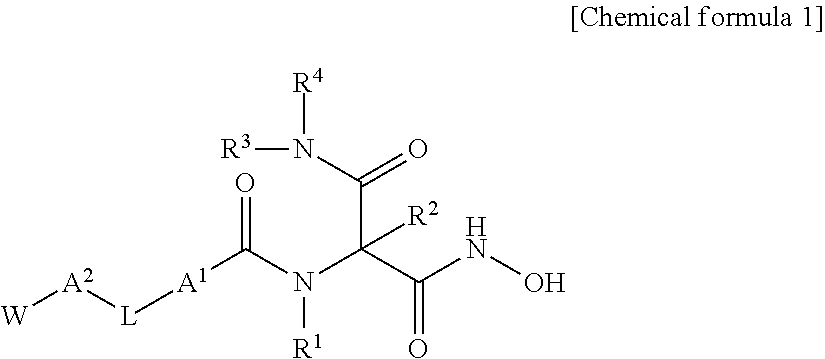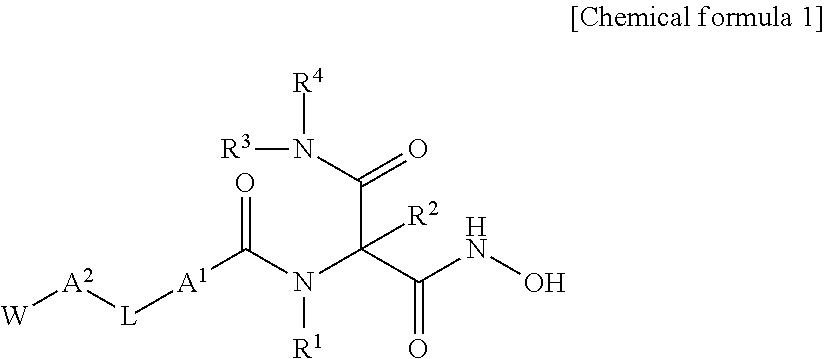Novel hydroxamic acid derivative
a technology of hydroxamic acid and derivatives, applied in the field of new hydroxamic acid derivatives, can solve problems such as major problems, and achieve the effect of strong lpxc-inhibiting action and potent antimicrobial activity
- Summary
- Abstract
- Description
- Claims
- Application Information
AI Technical Summary
Benefits of technology
Problems solved by technology
Method used
Image
Examples
example 1
2-[(Biphenyl-4-ylcarbonyl)(methyl)amino]-N-hydroxy-N′-methylpropanediamide (Compound 1)
[0502]
[0503](1) 4-Phenylbenzoyl chloride (2.23 g) was added little by little to a chloroform (20 mL) solution of N,N2,O-trimethyl-3-oxoserinamide hydrochloride (Intermediate 5-2, 2.02 g) and triethylamine (2.18 g) under ice cooling, and the mixture was stirred for 30 minutes at the same temperature and for 1 hour, with the temperature raised to room temperature. Water was added to the reaction mixture, and the system was extracted with chloroform. The extract was dried over anhydrous magnesium sulfate, and the desiccant was filtered out, whereafter the solvent was distilled off under reduced pressure. The resulting residue was purified by OH type silica gel column chromatography (gradient elution with chloroform / methanol=98 / 2→90 / 10) to obtain 4-{[1-methoxy-3-(methylamino)-1,3-dioxopropan-2-yl](methyl)carbamoyl}biphenyl (yellow solid) (3.0 g, 86%).
[0504]MS (ESI): 363 (M+Na)+, 339 (M−H)−
[0505]1H NMR...
example 2
N-hydroxy-N′-methyl-2-(methyl {[4′-(methylamino)biphenyl-4-yl]carbonyl}amino)propanediamide (Compound 2)
[0509]
[0510](1) 60% Sodium hydride (0.55 g) and methyl iodide (1.2 mL) were added to a DMF (6.0 mL) solution of t-butyl(4-(4,4,5,5-tetramethyl-1,3,2-dioxaborolan-2-yl)phenyl)carbamate (2.0 g), and the mixture was stirred for 18 hours at room temperature. Ethyl acetate and water were added to the reaction mixture, and the organic layer was isolated. The extract was washed sequentially with water and brine, and dried over anhydrous sodium sulfate. Then, the desiccant was filtered out, whereafter the solvent was distilled off under reduced pressure. Hexane was added to the residue, and the precipitated solid was collected by filtration to obtain t-butyl=methyl(4-(4,4,5,5-tetramethyl-1,3,2-dioxaborolan-2-yl)phenyl)carbamate (white solid) (1.46 g, 70%).
[0511]1H NMR (400 MHz, CHLOROFORM-d) δ ppm 1.34 (12H, s), 1.45 (9H, s), 3.27 (3H, s), 7.24 (2H, d, J=8.4 Hz), 7.76 (2H, d, J=8.4 Hz)
[05...
example 3
N-hydroxy-2-[{[4′-(methoxymethyl)biphenyl-4-yl]carbonyl}(methyl)amino]-N′-methylpropanediamide (Compound 4)
[0519]
[0520](1) A 28% sodium methoxide-methanol solution (5.0 g) was added to a methanol (40 mL) solution of 1-bromo-4-(bromomethyl)benzene (5.0 g) at room temperature, and the mixture was stirred for 21 hours at room temperature. Water was added to the reaction mixture, and the mixture was extracted with diethyl ether, whereafter the organic layer was dried over anhydrous magnesium sulfate. The desiccant was filtered out, and the filtrate was concentrated under reduced pressure. To a DMSO solution (40 mL) of the resulting residue, 4,4,4′,4′,5,5,5′,5′-octamethyl-2,2′-bi-1,3,2-dioxaborolane (7.6 g), PdCL2(dppf).CH2Cl2 (0.82 g), and potassium acetate (5.9 g) were added, followed by stirring the mixture for 4 hours at 100° C. After the system was allowed to cool, water (0.10 L) and ethyl acetate (0.10 L) were added, and the precipitated insolubles were filtered out. The filtrate w...
PUM
| Property | Measurement | Unit |
|---|---|---|
| Mass | aaaaa | aaaaa |
| Mass | aaaaa | aaaaa |
| Mass | aaaaa | aaaaa |
Abstract
Description
Claims
Application Information
 Login to View More
Login to View More - R&D
- Intellectual Property
- Life Sciences
- Materials
- Tech Scout
- Unparalleled Data Quality
- Higher Quality Content
- 60% Fewer Hallucinations
Browse by: Latest US Patents, China's latest patents, Technical Efficacy Thesaurus, Application Domain, Technology Topic, Popular Technical Reports.
© 2025 PatSnap. All rights reserved.Legal|Privacy policy|Modern Slavery Act Transparency Statement|Sitemap|About US| Contact US: help@patsnap.com



